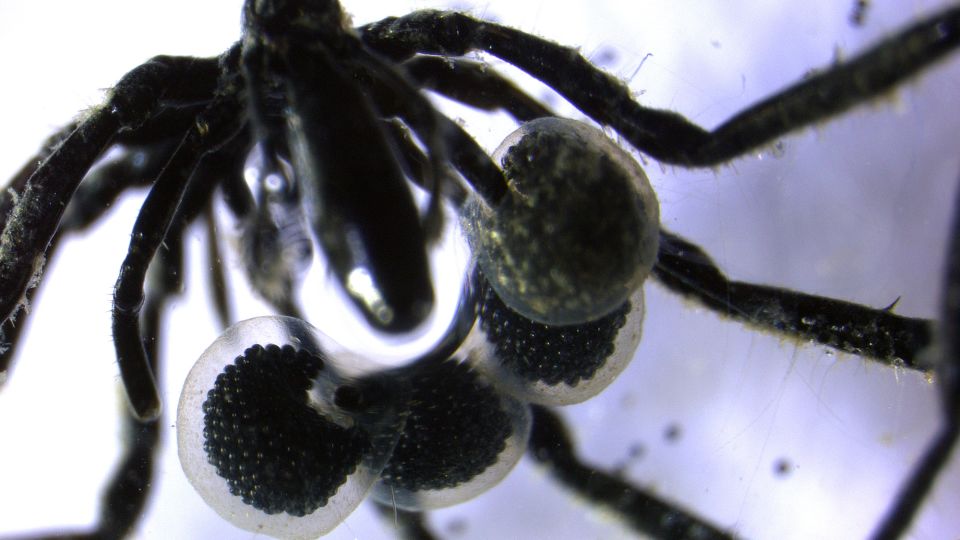Sign up for CNN’s Wonder Theory science newsletter. Explore the universe with news on fascinating discoveries, scientific advancements and more.
Heat-trapping methane may be best known for the dangers it poses to humans and Earth’s atmosphere, but in the dark depths of the ocean, the greenhouse gas is a nourishing meal for some of the world’s most mysterious creatures, new research suggests.
Scientists say they have discovered three previously unknown, unnamed species of sea spider off the US West Coast that could be teaming up with bacteria to thrive off gas bubbling from the seafloor in sparsely studied marine habitats known as methane seeps thousands of feet below the ocean’s surface.
In this symbiotic relationship, bacteria take up real estate on the spider’s exoskeletons, and in return, the microbes convert carbon-rich methane and oxygen into sugars and fats the spiders can eat, according to a study published Monday in the journal Proceedings of the National Academy of Sciences.
“Just like you would eat eggs for breakfast, the sea spider grazes the surface of its body, and it munches all those bacteria for nutrition,” said Shana Goffredi, a professor and chair of biology at Occidental College in Los Angeles and the study’s principal investigator. This unique nutrition strategy has never been observed in sea spiders before, she said.
Other species of sea spider share more in common with their terrestrial cousins, using large tubelike fangs to capture, immobilize and suck the fluids from soft-bodied prey, such as jellyfish, Goffredi explained. But lab observations of the newfound species, part of the Sericosura genus, revealed they lack the necessary appendages to capture prey, making them more akin to farmers harvesting methane-fueled bacteria from their own bodies.
It’s possible the spiders and their hitchhiking microbes play a crucial role in preventing methane — a natural gas thought to exacerbate global warming — from reaching Earth’s atmosphere, according to Goffredi.
“While the deep sea feels really far away, all organisms are interconnected. Even though they’re small, these animals have a big impact in that environment,” Goffredi said. “We can’t ever hope to sustainably (use) the oceans if we don’t really understand the oceans.”
The methane diet may be good for everyone
Light from the sun doesn’t reach the deep-sea ecosystem where the newly described Sericosura spider species make their home.
To survive in this dark environment, microbes evolved to use chemicals — instead of sunlight — for energy, explained marine biologist Nicole Dubilier, a professor and director of the department of symbiosis at the Max Planck Institute for Marine Microbiology in Germany. Dubilier was not involved in the study.
After marine life dies, it sinks to the seafloor and becomes buried, Dubilier said. In the process of decomposition, methane gas is released, escaping through the cracks of sediment as bubbles. Instead of floating away with the whims of the water column, the microbes that feed on the methane attach themselves to sea animals to remain among the bubbles.
By analyzing isotopes in the spiders’ tissues, the scientists determined the bacteria weren’t just hitching a ride from an eight-legged friend — they were also being eaten.
“This is really the beauty of the symbiosis between the two: The bacteria get that perfect Goldilocks zone with everything they need,” Dubilier said. “Even if 80% of the population are eaten (by the spiders), it’s worth it for the 20% to keep surviving and reproducing.”
While these Sericosura species are the first sea spiders caught feeding on the methane-fueled microbes, other deep-sea animals such as tube worms and sponges are known to share the rare diet, Dubilier noted.
Since the deep-sea ecosystem likely plays such a key role in keeping methane away from Earth’s atmosphere, Goffredi said one day, the same type of microbes found on the Sericosura spiders could be cultured to reduce water contaminants elsewhere.

The newfound sea spiders were collected from different areas off the coast of Southern California and Alaska. – Shana Goffredi
A meal for the next generation of sea spiders
The newly discovered Sericosura spiders are translucent and only span about 0.4 inch (1 centimeter) in length, so they likely can’t travel very far, Goffredi said. In fact, each of the three sea spider species collected for the study were from different areas off the coast of Southern California and Alaska — a clue that the populations are highly localized.
Since the spiders are so small, many of their organs are found inside of their appendages. To mate, the female spiders shoot hundreds of eggs from their kneecaps, which the male spiders collect into saclike bundles looped around their legs like bracelets, the study found.
Once the eggs hatched, Goffredi’s team noticed bacteria living on the father spiders attached itself to the hatchlings, providing them with an early source of food.
Studying microbiome inheritance in animals could potentially help scientists understand more about how humans’ gut bacteria, for example, is passed between mothers and newborn children, Dubilier said.
Further exploration of the seafloor could also uncover additional, similar sea spider species, Goffredi said.
“People tend to think of the deep sea as a kind of homogeneous ecosystem, but that’s actually untrue. There’s a lot of biodiversity by region and animals are very localized to specific habitats on the seafloor,” Goffredi said. “You have to be very careful if you decide to use the seafloor for mining, for example. We don’t want to cause any kind of irreparable harm to very specific habitats that aren’t found anywhere else.”
For more CNN news and newsletters create an account at CNN.com

